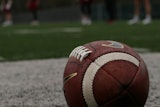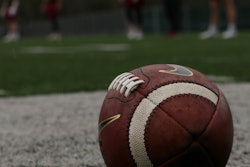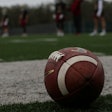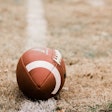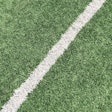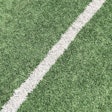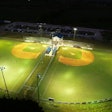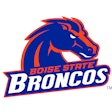![[Photos courtesy of OKC Dodgers]](https://img.athleticbusiness.com/files/base/abmedia/all/image/2018/04/ab.baseball418_feat.png?auto=format%2Ccompress&q=70&w=400)
America's pastime is a time-consumer. Just ask anyone entrusted with prepping a baseball playing surface, which can encompass as many as four distinct surface types. Today, a single baseball field might feature natural grass, synthetic turf, a screened-gravel warning track and finally an infield mix that may represent several different concentrations of sand and clay based on location on the diamond.
Take a swing at naming another sport that challenges its groundskeepers as much. You'd have better luck chasing a two-strike slider in the dirt.
"That's what really makes the maintenance of a baseball field somewhat unique," says Monte McCoy, who for 22 years has been grooming the home of the Oklahoma City Dodgers, the Triple-A affiliate of the MLB club in Los Angeles. "You're dealing with so many different aspects of the total groundskeeping experience."
The one aspect that commands most of McCoy's focus — and that of field maintenance professionals at every level — is tending to the circuit around which the game revolves: the pitcher's mound, home plate area and base paths. While turfgrass thrives organically given proper assistance, the infield dirt requires near-constant preparation and repair.
"People would be amazed," McCoy says. "You treat the grass right, it will take care of itself, but we spend 75 to 80 percent of our day on the dirt — repacking mounds, dragging, spot dragging, watering. Because it's hot and windy in Oklahoma, we're soaking it six, seven times a day to keep it ready for the players when they come out for batting practice."
Last October, McCoy held a free groundskeeping clinic at the Dodgers' Chickasaw Bricktown Ballpark that drew more than 100 high school, college and recreation professionals from around the state. It was a launch party of sorts for OKC Dodgers Sports Field Services. "We're going out and consulting, renovating and constructing athletic fields for high schools and colleges here in Oklahoma City, and that was kind of a kickoff for us to have that educational forum for all coaches and parks and rec workers," he says. "A lot of them don't necessarily have a background in field maintenance, and they're looking at anything to further their education to help them out in their own job."
Here's a look at the major challenges associated with a baseball field's skinned areas:
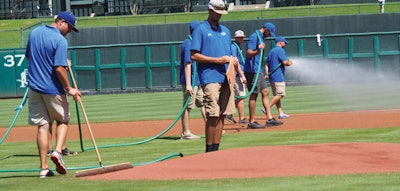
Mix and moisture
Most infield material is a mixture of sand, silt and clay, with varying compositions in different locations of the country, at different levels of play and even on the same diamond.
Because he has the time and resources to pamper a playing surface that serves professionals who are one step away from the big leagues, McCoy's mix is heavier than most — with 40 percent clay concentration in most areas of the infield. Lower levels of competition, where watering may be limited by time or municipal restriction to a couple times per week, are likely better served by a 70/30 sand-to-clay ratio.
"A lot of times I'll suggest a change to their infield mix," McCoy says. "We use a real high-clay-content infield mixture, but I may have them back off to a little sandier mix, where it's not going to get as hard. Obviously, on a high-clay field, the hotter it gets, and if you're not able to keep it moist, it's going to crack and get hard as a rock. If you have a little sandier type infield mixture, it's a little easier to maintain. And there are also different soil conditioners that you can add to it — calcined clays or the vitrified clays that will help hold moisture a little bit longer."
Too sandy, and infield material will be susceptible to rain and wind erosion. McCoy recently amended a high school infield with 75 tons of a mix more closely resembling the kind used at Chickasaw Bricktown Ballpark.
If a full infield tarp isn't feasible or water use is restricted, at least the home plate and mound areas should be watered as much as possible, even if at the expense of the rest of the diamond, and covered when the field is not in use. "I try to explain to coaches that the tarp is great for keeping water off, but the most important thing for home plate and mound tarps is to keep moisture in," McCoy says. "At the end of the game, at the end of the night or the next morning, whenever you rebuild those areas, you can cover them, and it will help manage the moisture. A lot of people think we just put the tarps out when it's going to rain. To me, they're just as important to keep moisture in."
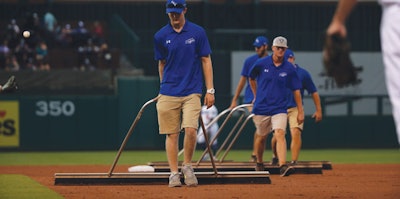
Rut repair
The telltale sign of an overused, underserved baseball diamond is depressions in the batter's boxes. Not only do these areas see a lot of foot traffic, it's aggressive foot traffic, as players dig in during at-bats.
Clay bricks are sometimes installed below grade to mitigate the displacement of material, but McCoy has better luck simply upping his infield mix's clay content closer to 50 percent in the home plate area, and then watering and tamping.
"I like using a good commercial clay, adding a little bit at a time and packing it in with a vibratory plate. You're going to get it just as hard as clay bricks," he says, adding of the brick method, "Basically you're having to get it level twice when you're doing it that way. Before you get those bricks in, you're going to have to make sure your sub-base is perfect or it's going to be too high or too low, and then you're going to have to scrape it out and bring commercial clay on top of that anyway. If you put bricks in and you're expecting to play in the heat all summer long, and you're not able to keep moisture on it, it's just going to crack and break out, and you're not really accomplishing anything."
Mound building
Like the home plate area, pitcher's mounds can be built in one of two ways: in a gradual water-and-tamp process involving a heavy clay concentration, or with top-dressed bricks, which can be used to fortify the plateau surrounding the rubber and the mound's sloped landing area.
Not surprisingly, McCoy prefers the measured build-up approach, which allows him to more carefully control the one-inch-per-foot grade required from the rubber to the front of the mound without having to potentially remove material in the event he miscalculates the sub-base. "I guess maybe I'm just not that good, because every time I've tried bricks I end up getting it too high," McCoy says. "If you don't get that slope perfect, if you're high there and you put the bricks in and saturate those and get those tamped in, then you have to come in and try to scrape a lot of that out, and it's just really hard to do that. If you build it slowly inch by inch, for me, it's just a lot easier process to deal with."
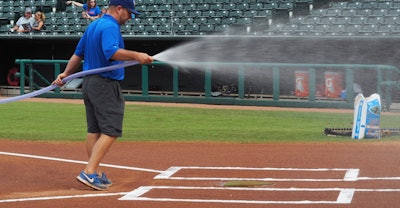 Opposite: Dragging faster than a person can walk can lead to displacement of infield material and formation of dangerous lips. Above: Moisture management is key to creating a safe playing surface, particularly in clay-heavy areas such as home plate.
Opposite: Dragging faster than a person can walk can lead to displacement of infield material and formation of dangerous lips. Above: Moisture management is key to creating a safe playing surface, particularly in clay-heavy areas such as home plate.
Lipped edges
Migration of infield material from skinned areas into natural grass or even synthetic turf must be monitored and addressed in a timely manner. More than rain and wind, the main cause of material buildup where it doesn't belong is improper dragging technique. Dragging too fast, particularly if a tractor is involved, will throw infield dirt into the infield and outfield grass, where it can form a lip over time. Not only does this pose a danger of bad hops, but it likely will dam the drainage of the field from infield to outfield and from infield to foul territory. A drag should never travel faster than a person can walk, according to McCoy.
A power broom or leaf rake can be used regularly to return wayward material to the infield, but if lips form over the course of a season, a power rake can be brought in to pulverize the soil, break up the packed material and allow it to be raked out. "It's almost like a dethatching machine, but it's really aggressive and you can run it over the lip and it will actually pull out all the infield mixture and the conditioner that's gotten up on your edge throughout the season and leave it flush with the dirt," McCoy says. "It's really aggressive on your grass, but if you do it with plenty of growing season left, it will fill back in and you won't have the lip."
Baseline options
McCoy reports that roughly nine out of every 10 high school and collegiate baseball diamonds in Oklahoma have gone to natural grass baselines between home and first base and between third and home. Proponents point to savings on maintenance (less raking and edging) and materials (weekly line painting versus daily chalk), but McCoy isn't convinced: "I would suggest to them to just make the baseline four to six inches wider than your drag, and you can drag it as you're dragging the rest of your field."
He's had to renovate fields that — in the process of being converted from dirt baselines to grass — had sod laid too high, thus impeding infield drainage and adversely influencing ball roll. "We had to come in and actually excavate some soil back out and re-sod it to get it back to proper drainage," McCoy says. "I'm a purist when it comes to stuff like that. I think you should have baselines. They say, 'When it rains, we have less to worry about to get ready.' Generally, baselines are going to be the least of your concerns if you get a rain the night before. You're going to have bigger issues than the baselines."
Standing water
There are several approaches to dispersing puddles, which often appear in high-wear areas of the infield, such as the spots where defensive players are positioned or the sliding area approaching second base.
"Keeping it level in those areas the best you can always is number one to having good drainage for your skinned area," McCoy says, adding of standing water, "The first thing I always say is, 'Do not get a broom. Do not get a squeegee out, or a drag to go through it,' because a lot of people just horse through there with a tractor and drag."
A less disruptive approach to water dispersion is to take a the same one-inch hose used to water the field, make sure it's weighted down with some water in it, and then have two crew members spaced wider than the affected area slowly drag the hose broadside through the standing water four or five times to spread it widely over the infield dirt. In the event a drying agent is applied, McCoy recommends removing it as soon as possible. "As soon as you get the water all soaked up, actually scoop that material back out. We just take it and discard it," he says. "You can move it around, but if you start doing that a lot, it starts affecting your infield playability."
McCoy, who plans to host a second OKC Dodgers Sports Field Services clinic in August or September, realizes he has the luxury of time that a lot of groundskeepers toiling below the Triple-A level don't, but he offers this takeaway message: utilize every resource. "I have a lot of high school coaches who will say, 'Oh, man, I wish we had a four-man staff like you.' Well, you do. You have 20 guys over there, counting coaches, who can help do their part, and it saves a lot. You can accomplish a lot. Just try to utilize as many resources as you have available to you."
This article originally appeared in the April 2018 issue of Athletic Business with the title "The Dirt: Basics for keeping your baseball infield playable and safe." Athletic Business is a free magazine for professionals in the athletic, fitness and recreation industry. Click here to subscribe.














